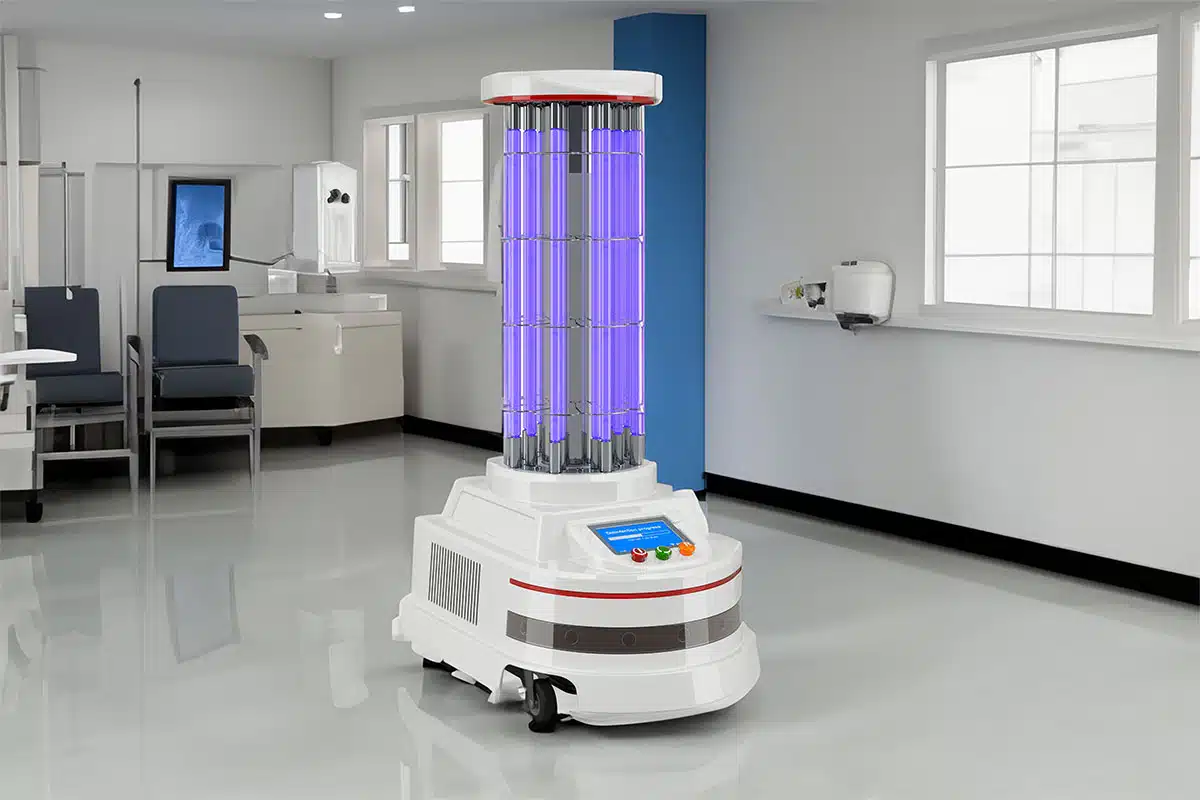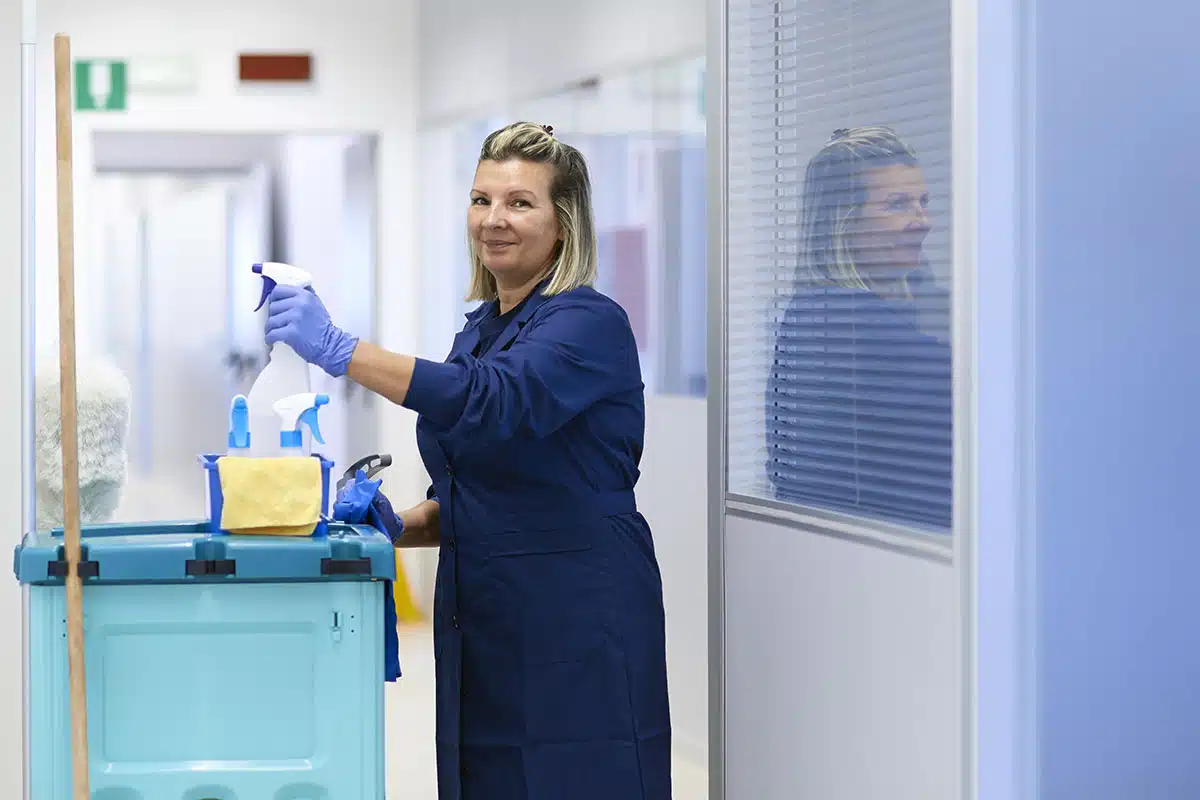For much of human history, little was known about the spread of disease. In fact, modern germ theory wasn’t widely accepted until the late 19th century. Prior to this time, few doctors washed their hands between patients nor were hospital surfaces cleaned with disinfection in mind. Even at the start of the modern era, hospital cleaning services were about keeping up appearances, not mitigating disease.
Things have come a long way since then. Gone are the days when a mop bucket and a rag were all that was needed in a hospital cleaning toolkit. Today, hospital cleaning services use high-tech systems that not only target visible dirt and grime, but also the microscopic contaminants that hide beyond the naked eye.
Trends in Hospital Cleaning Services
Advances in technology and data-driven, targeted approaches to hospital cleaning can reduce the risk of healthcare-associated infections.
Advances in technology and data-driven, targeted approaches to hospital cleaning can result in reduced risk of healthcare-associated infections among both patients and staff. These advances, combined with a greater understanding of disease mitigation, are driving seven important trends in hospital cleaning services.
Targeted Pathogen Cleaning
Historically, cleaning and disinfecting environmental spaces in a hospital setting meant killing any and all potential pathogens, including viruses, bacteria, fungi, and others. However, the misuse of antibiotics has led to the rise of antibiotic-resistant pathogens, including Methicillin-resistant Staphylococcus aureus (MRSA) and Vancomycin-resistant Enterococcus faecalis/faecium (VRE). MRSA and VRE are especially concerning in a hospital setting, as both can be spread via contaminated objects. It’s essential to target these specific pathogens when cleaning.
Some of the most common chemicals that are approved by the Environmental Protection Agency (EPA) to kill both MRSA and VRE are quaternary ammonium, sodium hypochlorite (bleach) and hydrogen peroxide, all of which can be found in numerous brands of commercial cleaning products. These products have a minimum kill time for each pathogen, meaning they must remain on the surface for a specified amount of time in order to be effective, typically 2–10 minutes. Another common pathogen in a hospital setting is Clostridium difficile (C. diff). Outside the body, C. diff takes the form of spores, which can be killed with EPA-approved chemicals, including sodium hypochlorite.
Continuous Active Disinfection (CAD)
Traditional cleaning usually involves applying disinfectant to a surface and repeating as necessary. It comes as no surprise that in a healthcare setting, surfaces become re-contaminated very quickly, calling for frequent reapplication of disinfectants. This requires not only a great deal of labor, but also means the areas being cleaned must be off-limits during the cleaning time.
To address this challenge, many healthcare facilities have adopted continuous active disinfection (CAD) protocols. These protocols rely on the use of disinfectants that have been formulated to kill pathogens for up to 24 hours after application. (These disinfectants work by leaving behind a polymer-based, multi-layer pathogen-neutralizing film.) Because patient and procedure rooms are cleaned and disinfected between patients, these products are more likely to be used in common areas such as waiting rooms, which see higher use and where cleaning occurs less frequently.
If you want to know more about a particular cleaning product, the EPA has a tool that can be used to look up an individual product by its registration number, which is required on all packaging. The tool includes data about the product’s EPA test results for specific contaminants, recommended contact times, and uses. The EPA has only recently released guidance for products adding residual efficacy claims, so that data may not yet be available for all listed products.
Advances in UV Technology
The use of ultraviolet light in hospital disinfection isn’t new. One technology—ultraviolet germicidal irradiation (UVGI)—has been around for more than a century. This technology uses specialized lamps to administer UV light (more specifically, UV-C light), which damages the DNA of bacteria, viruses, and other pathogens.
In the early 1900s, UVGI was used to disinfect the water supply in Marseille, France. In the 1930s, it was used in Philadelphia schools to disinfect the air and prevent a measles outbreak. It has also been used in hospital settings to prevent tuberculosis. This particular UVGI application, known as upper-room UVGI, uses specialized UVGI devices to eradicate airborne pathogens. With this technique, air flows into UVGI devices from fans or open windows (or today, from HVACs). The UV energy kills the airborne pathogens and returns the clean air to the space.
Historically, UV light has been administered via low-pressure mercury-vapor lamps. But advances in technology mean it can now be administered via light-emitting diodes (LED), which are believed to be safer. It should be noted that UVGI does not replace traditional cleaning methods; rather, it complements them.
Robots and Automated Systems
One of the challenges of effective hospital cleaning is ensuring every nook and cranny is cleaned and disinfected. Cleaning robots have made this easier, as these machines can be used for cleaning floors, ducts, windows, and more. In a hospital setting, disinfection robots can also be used to get to spots that human beings can’t. These programmable, remote-controlled devices can use chemicals or UV light to disinfect areas with potential pathogens without risking the health of cleaning personnel.
For example, some hospitals now use rolling, autonomous towers equipped with circulating, vertically set UV-C lamp tubes on all sides to destroy pathogens via ultraviolet radiation. These towers have a wheeled base that enables them to roll through patient or procedure rooms on their own, eliminating any potential risk of UV light to humans. Similarly, programmable, fog-disinfection robots use a retractable, chimney-like spout to spray a fine disinfecting mist throughout a space.

Data-Driven Hospital Cleaning Services
Despite all of the advances in technology, the use of solid data to inform cleaning procedures remains one of the most important trends in hospital cleaning services. Having the proper procedures in place is essential, but understanding whether those procedures are working is even more important. Internet-connected cleaning devices, facility management software, and other smart technologies work in unison to provide real-time information and improved efficiency.
High-tech dispensers can notify staff that hand soap is running low in a restroom, providing key data on usage and traffic patterns. Admissions and discharge records can indicate when patient rooms are vacant and therefore available for cleaning. This real-time data can help facilities managers adjust staffing and prioritize tasks, thus reducing the frequency of static cleaning in disused areas.
Eco-Friendly Options
“Eco-friendly” isn’t a term typically associated with cleaning chemicals. But in truth, the two aren’t mutually exclusive. Concerns over the environmental and health impacts of traditional products has led to a rise in the number of eco-friendly products on the market. Many of today’s products are nontoxic and biodegradable, while maintaining the disinfecting properties of their more toxic counterparts. These products are free of ammonia, phosphates, and volatile organic compounds.
Citric acid, for example, is an effective disinfectant against MRSA and VRE, but isn’t harmful to humans. It’s also rapidly biodegradable in water and soil. Hydrogen peroxide is similarly safe for humans and the planet; it’s a powerful disinfectant but poses no danger if used correctly.
Electrostatic Spraying/Misting Systems

Increasing efficiency and reducing the likelihood of human error is essential in hospital cleaning, and electrostatic spraying checks both boxes. Unlike dry dusting or wet cleaning, electrostatic spraying uses an atomized mist that adheres to surfaces, even in hard-to-reach spots.
The mist can be applied manually by a technician (using a handheld sprayer) or by machine. One system consists of a box-like fogging device that can be placed in a room and turned on remotely. Still others take the form of robots, which can be programmed to move throughout a room while expelling the disinfecting solution.
What to Look for in Hospital Cleaning Services
As cleaning technologies have evolved, so have hospital cleaning services. So how can you find the right service for your healthcare facility? Here are some factors to keep in mind when looking for a cleaning partner.
State-of-the-Art Products
The best hospital cleaning services use modern cleaning products and equipment. Disinfectants must be EPA-registered to kill both bacteria and viruses, including COVID-19. Services should use the latest cleaning technology and all equipment should be in excellent working order.
Sustainability
Cleaning products don’t have to be toxic to be effective. When possible, they should align to the EPA’s Safer Choice criteria to be free of ammonia, phosphates, and volatile organic compounds. In addition, custodial and cleaning protocols should be certified by the Cleaning Industry Management Standards for Green Buildings. And it’s even better if they can help organizations earn points toward Leadership in Energy and Environmental Design (LEED) certification.
Experience and Expertise
Want the job done right? Hospital cleaning providers should have plenty of experience working in a range of hospital settings. With this experience, of course, comes expertise. Staff should be continuously trained in the latest trends in hospital cleaning and safety, including bloodborne pathogen disposal, proper handwashing, two-pass disinfection protocols, and airborne and contact precautions. They should also be HIPPA-compliant, if and when appropriate.